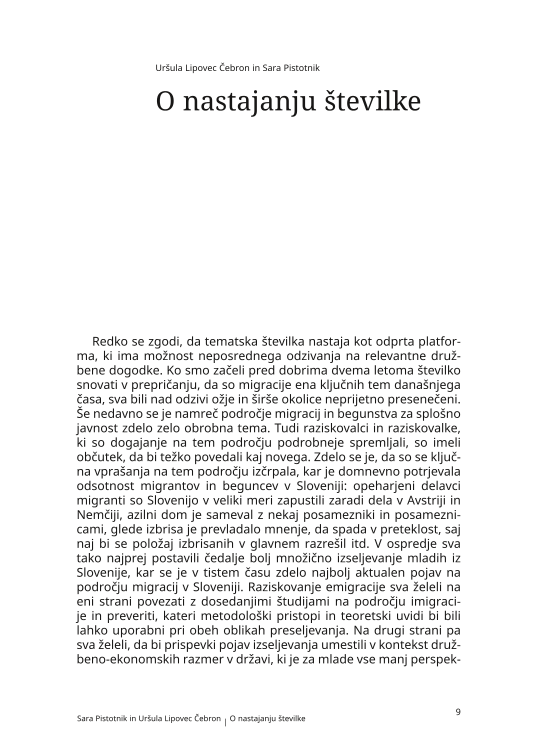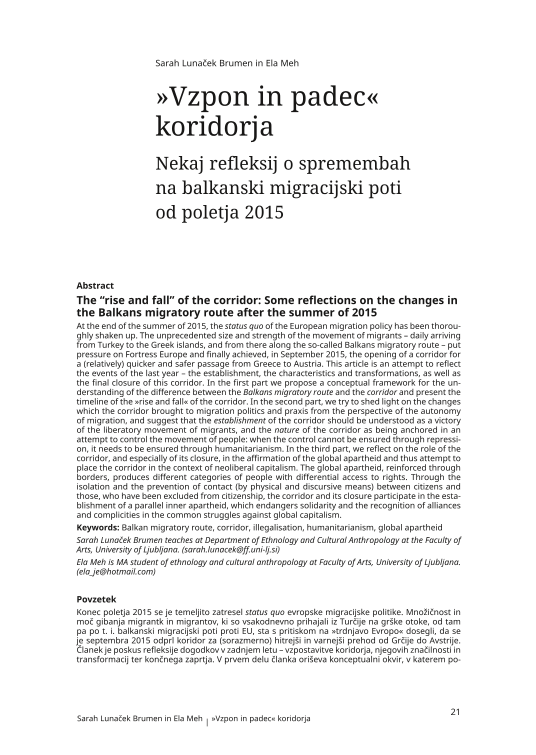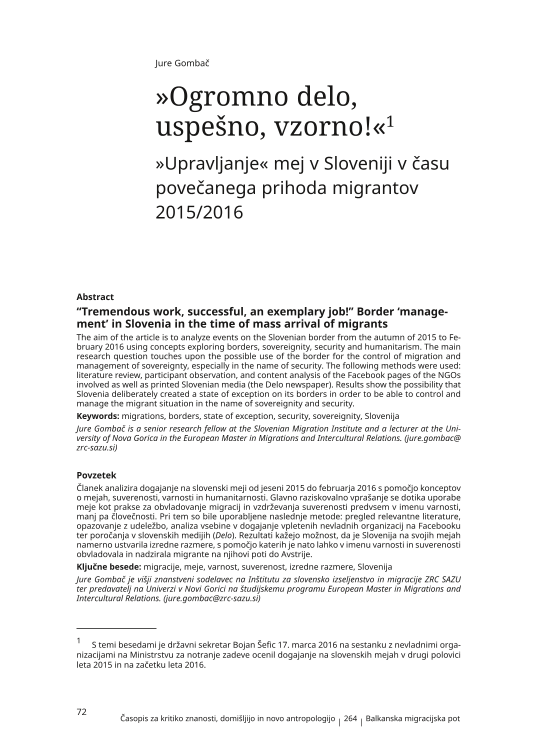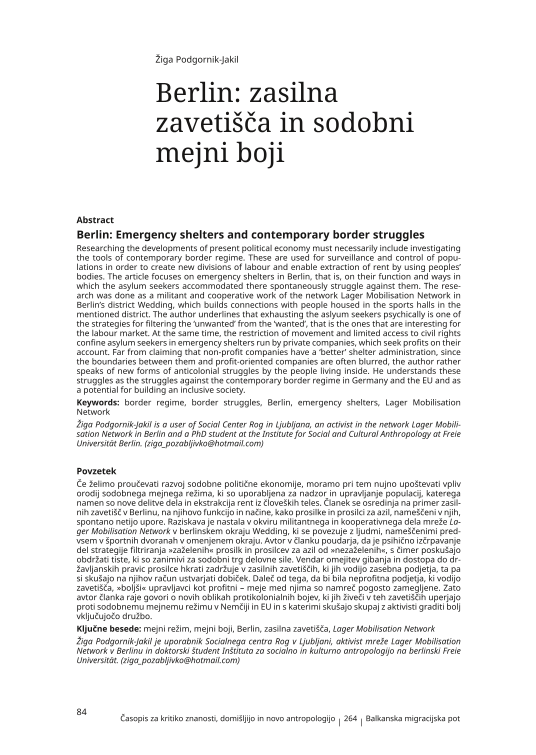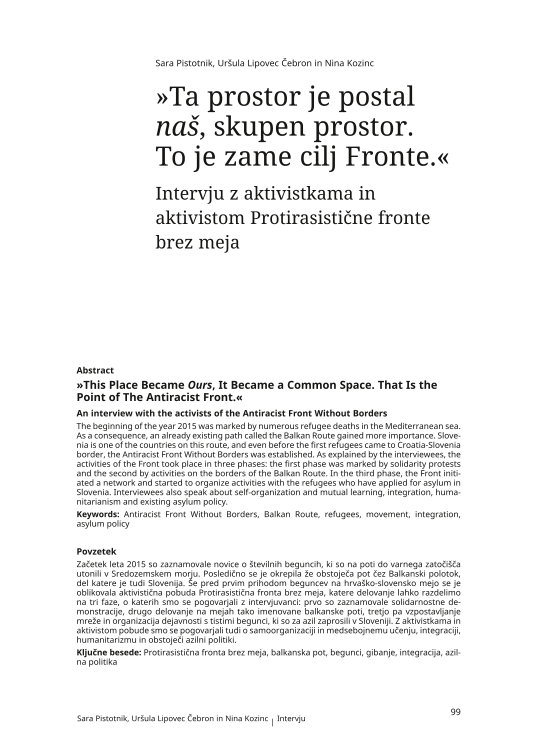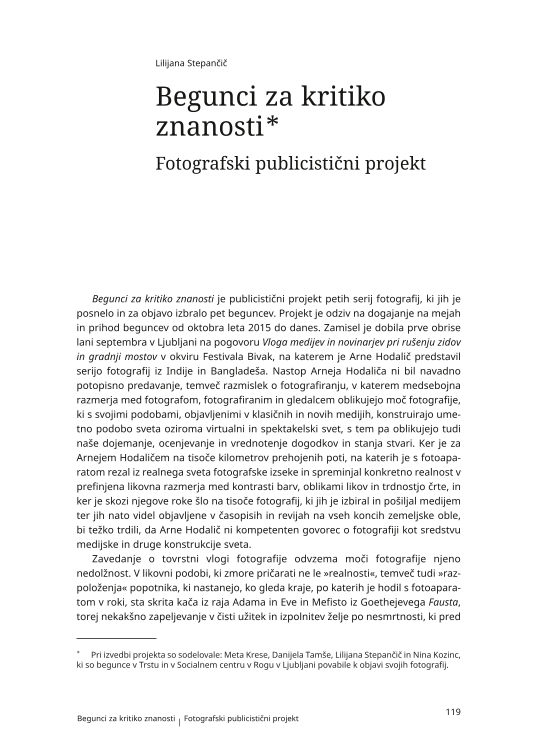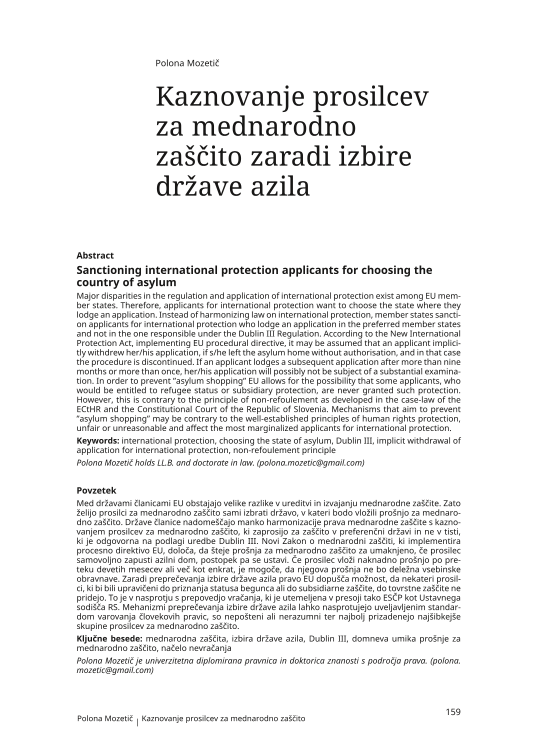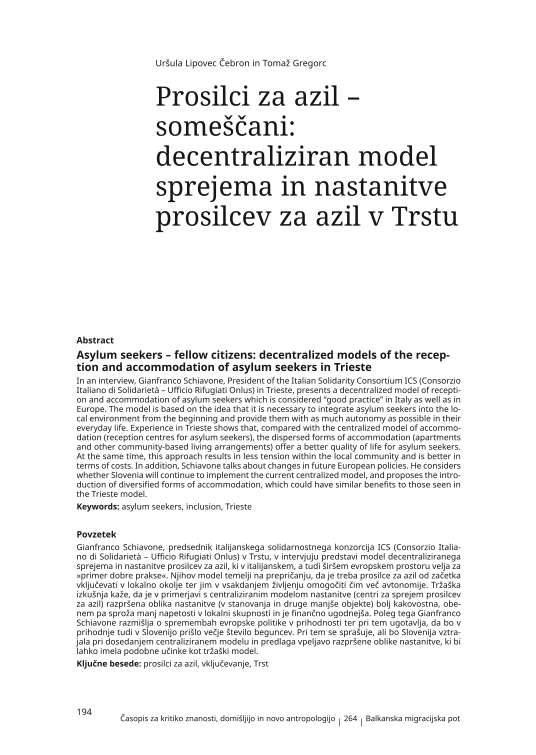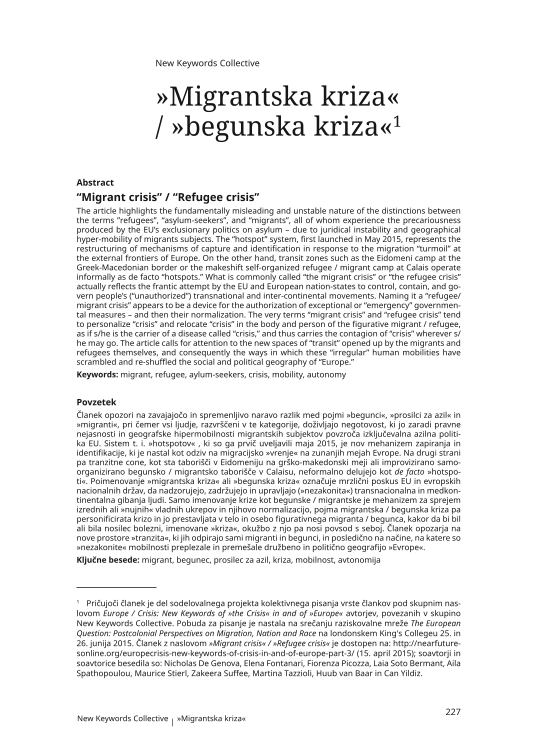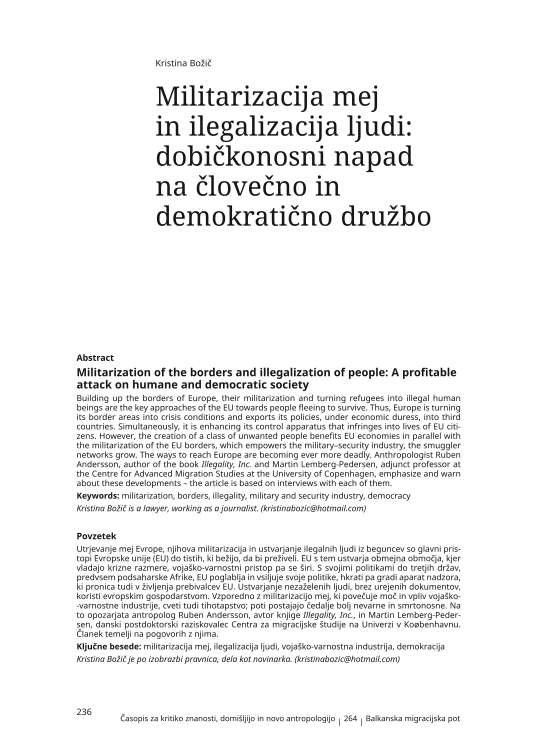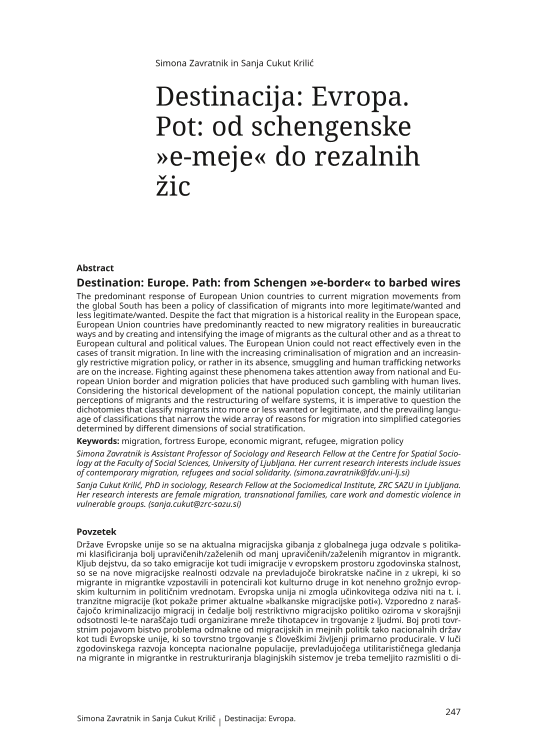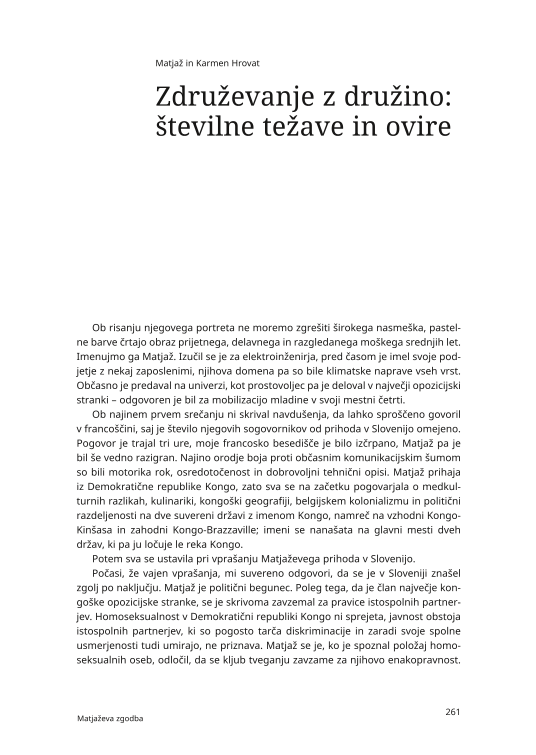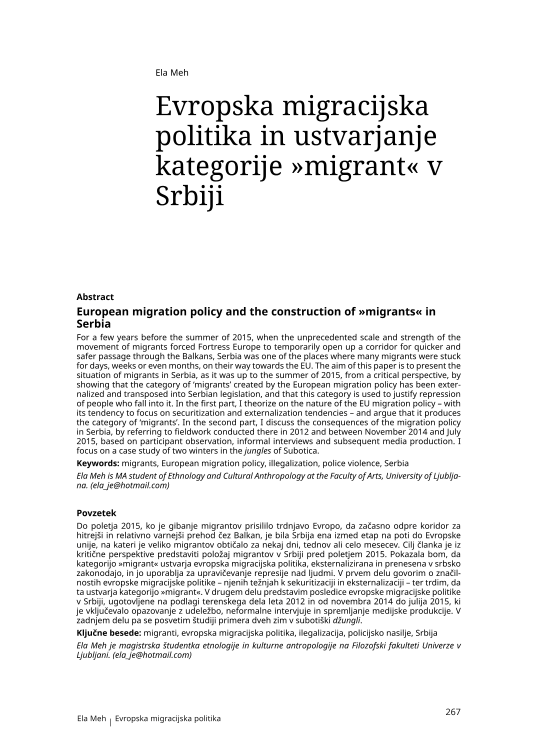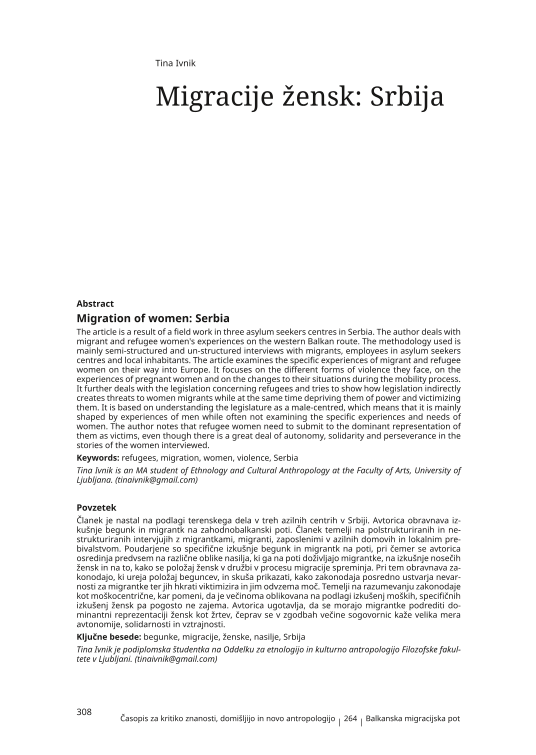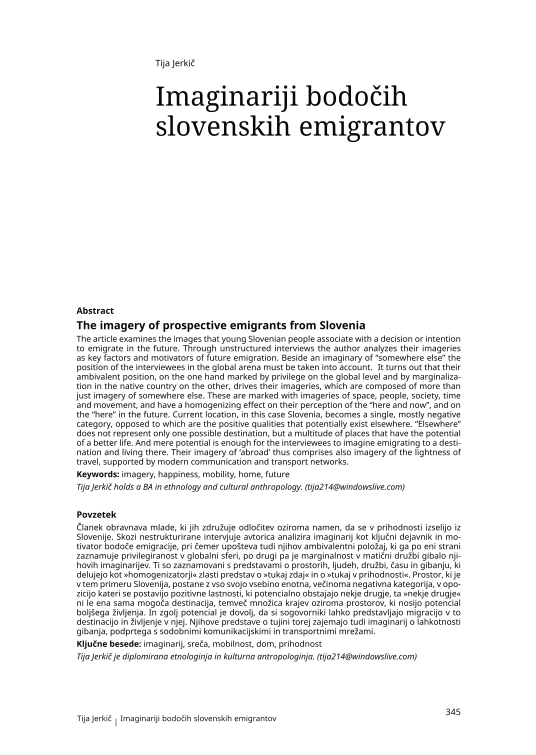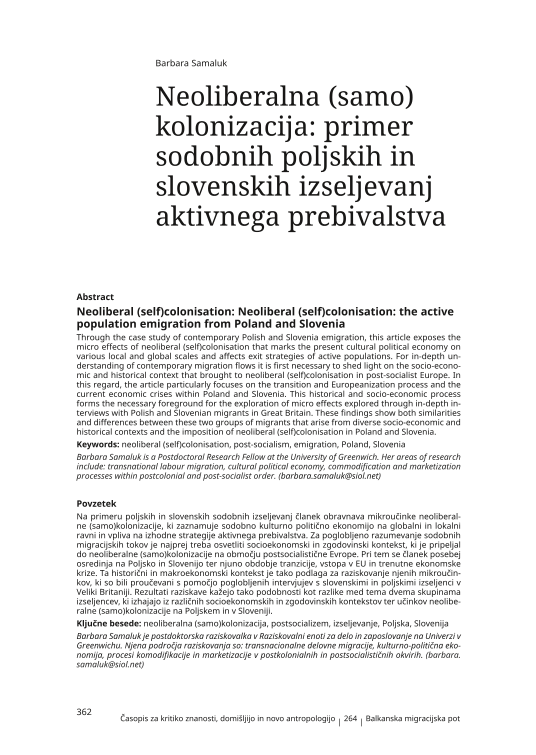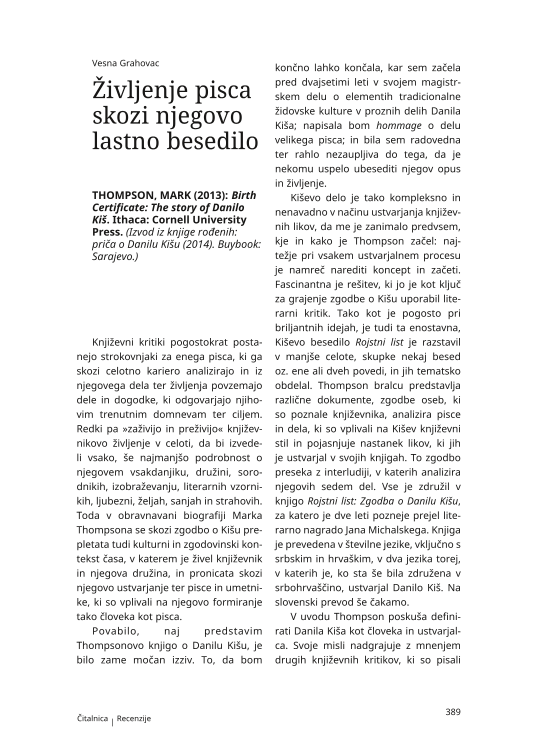Redko se zgodi, da tematska številka nastaja kot odprta platforma, ki ima možnost neposrednega odzivanja na relevantne družbene dogodke. Ko smo začeli pred dobrima dvema letoma številko snovati v prepričanju, da so migracije ena ključnih tem današnjega časa, sva bili nad odzivi ožje in širše okolice neprijetno presenečeni. Še nedavno se je namreč področje migracij in begunstva za splošno javnost zdelo zelo obrobna tema. Tudi raziskovalci in raziskovalke, ki so dogajanje na tem področju podrobneje spremljali, so imeli občutek, da bi težko povedali kaj novega. Zdelo se je, da so se ključna vprašanja na tem področju izčrpala, kar je domnevno potrjevala odsotnost migrantov in beguncev v Sloveniji: opeharjeni delavci migranti so Slovenijo v veliki meri zapustili zaradi dela v Avstriji in Nemčiji, azilni dom je sameval z nekaj posamezniki in posameznicami, glede izbrisa je prevladalo mnenje, da spada v preteklost, saj naj bi se položaj izbrisanih v glavnem razrešil itd. V ospredje sva tako najprej postavili čedalje bolj množično izseljevanje mladih iz Slovenije, kar se je v tistem času zdelo najbolj aktualen pojav na področju migracij v Sloveniji. Raziskovanje emigracije sva želeli na eni strani povezati z dosedanjimi študijami na področju imigracije in preveriti, kateri metodološki pristopi in teoretski uvidi bi bili lahko uporabni pri obeh oblikah preseljevanja. Na drugi strani pa sva želeli, da bi prispevki pojav izseljevanja umestili v kontekst družbeno-ekonomskih razmer v državi, ki je za mlade vse manj perspektivna. Kljub preoblikovanju teme pa je odziv potencialnih avtoric in avtorjev ostal skromen – zadostoval je le za manjši tematski blok, zato sva se znova začeli spraševati o smiselnosti urejanja te številke.
Zubair prihaja iz Afganistana in je računalniški inženir. Leta 1994, ko je bil star osem let, se je skupaj z družino preselil v Pakistan, od koder so se vrnili leta 2002. Zubair je začel obiskovati sedmi razred kabulske srednje šole Amani (Fderverein Amani-Oberrealschule Kabul), v kateri je bil učni jezik nemščina. Sočasno se je učil tudi dari, ki ga pred tem ni govoril. Po končani srednji šoli se je vrnil v Pakistan, kjer je na Univerzi Iqra diplomiral iz računalništva. Naslednji dve leti je preživel v Indiji, kjer je na Ghandijevi univerzi pridobil dva magisterija, in sicer na programih Računalniški inženiring in Mrežne tehnologije. V Afganistan se je vrnil leta 2009 in eno leto pozneje pridobil tako Microsoftov kot tudi CISCO-v certifikat za mrežnega inženirja.
At the end of the summer of 2015, the status quo of the European migration policy has been thoroughly shaken up. The unprecedented size and strength of the movement of migrants – daily arriving from Turkey to the Greek islands, and from there along the so-called Balkans migratory route – put pressure on Fortress Europe and finally achieved, in September 2015, the opening of a corridor for a (relatively) quicker and safer passage from Greece to Austria. This article is an attempt to reflect the events of the last year – the establishment, the characteristics and transformations, as well as the final closure of this corridor. In the first part we propose a conceptual framework for the understanding of the difference between the Balkans migratory route and the corridor and present the timeline of the »rise and fall« of the corridor. In the second part, we try to shed light on the changes which the corridor brought to migration politics and praxis from the perspective of the autonomy of migration, and suggest that the establishment of the corridor should be understood as a victory of the liberatory movement of migrants, and the nature of the corridor as being anchored in an attempt to control the movement of people: when the control cannot be ensured through repression, it needs to be ensured through humanitarianism. In the third part, we reflect on the role of the corridor, and especially of its closure, in the affirmation of the global apartheid and thus attempt to place the corridor in the context of neoliberal capitalism. The global apartheid, reinforced through borders, produces different categories of people with differential access to rights. Through the isolation and the prevention of contact (by physical and discursive means) between citizens and those, who have been excluded from citizenship, the corridor and its closure participate in the establishment of a parallel inner apartheid, which endangers solidarity and the recognition of alliances and complicities in the common struggles against global capitalism.
Humanitarian Power – Rough Care: National politics of asylum in the humanitarian (biopolitical) framework
(
Based on a short field research conducted at the refugee transit center in Slavonski Brod, the paper analyzes contemporary asylum policies in Croatia. The author is suggesting that the structure and function of a centre plays a crucial role in the securitization and humanitarization of the asylum policy. The analysis has shown that the asylum policy in Croatia has the same structure as the dominant asylum policies in Europe. Both of them oscillate between two poles: compassion and repression. Humanitarian policy in Croatia is more restrictive and is based on radical inequality, nationalism, racism, the suspension of rights and the normalization of structural violence. Due to its exclusive national focus, it will not provide any long term solutions for dealing with refugees in the future.
The purpose of the article is to analyse the migration corridor managed by the state authorities on the Balkan migration route in the second half of 2015, understand it from the perspective of the existing legal and institutional frameworks, and show that the corridor was a phenomenon outside of national and European positive law, while at the same time it responded to the requirements of international human rights principles. The corridor was a clear, intentional and coordinated deviation from legal provisions. It amounted to a state of exception, a certain level of state of emergency in which the rules adopted by the national and European legislatures were suspended and replaced by internal instructions or decrees, or even with constantly changing state practices. The analysis involved comparison of a positive normative framework with the actual procedures carried out by the state structures, and identification of discrepancies which were then qualitatively evaluated from the perspective of international standards. Another purpose of the article was to show that the corridor which was also sometimes referred to as a “humanitarian corridor”, only seemed humanitarian since in fact it served a completely different purpose, namely the interests of state authorities for the refugees and migrants to leave their territories as quickly as possible.
The aim of the article is to analyze events on the Slovenian border from the autumn of 2015 to February 2016 using concepts exploring borders, sovereignity, security and humanitarism. The main research question touches upon the possible use of the border for the control of migration and management of sovereignty, especially in the name of security. The following methods were used: literature review, participant observation, and content analysis of the Facebook pages of the NGOs involved as well as printed Slovenian media (the Delo newspaper). Results show the possibility that Slovenia deliberately created a state of exception on its borders in order to be able to control and manage the migrant situation in the name of sovereignity and security.
Researching the developments of present political economy must necessarily include investigating the tools of contemporary border regime. These are used for surveillance and control of populations in order to create new divisions of labour and enable extraction of rent by using peoples’ bodies. The article focuses on emergency shelters in Berlin, that is, on their function and ways in which the asylum seekers accommodated there spontaneously struggle against them. The research was done as a militant and cooperative work of the network Lager Mobilisation Network in Berlin’s district Wedding, which builds connections with people housed in the sports halls in the mentioned district. The author underlines that exhausting the aslyum seekers psychically is one of the strategies for filtering the ‘unwanted’ from the ‘wanted’, that is the ones that are interesting for the labour market. At the same time, the restriction of movement and limited access to civil rights confine asylum seekers in emergency shelters run by private companies, which seek profits on their account. Far from claiming that non-profit companies have a ‘better’ shelter administration, since the boundaries between them and profit-oriented companies are often blurred, the author rather speaks of new forms of anticolonial struggles by the people living inside. He understands these struggles as the struggles against the contemporary border regime in Germany and the EU and as a potential for building an inclusive society.
The beginning of the year 2015 was marked by numerous refugee deaths in the Mediterranean sea. As a consequence, an already existing path called the Balkan Route gained more importance. Slovenia is one of the countries on this route, and even before the first refugees came to Croatia-Slovenia border, the Antiracist Front Without Borders was established. As explained by the interviewees, the activities of the Front took place in three phases: the first phase was marked by solidarity protests and the second by activities on the borders of the Balkan Route. In the third phase, the Front initiated a network and started to organize activities with the refugees who have applied for asylum in Slovenia. Interviewees also speak about self-organization and mutual learning, integration, humanitarianism and existing asylum policy.
Begunci za kritiko znanosti je publicistični projekt petih serij fotografij, ki jih je posnelo in za objavo izbralo pet beguncev. Projekt je odziv na dogajanje na mejah in prihod beguncev od oktobra leta 2015 do danes. Zamisel je dobila prve obrise lani septembra v Ljubljani na pogovoru Vloga medijev in novinarjev pri rušenju zidov in gradnji mostov v okviru Festivala Bivak, na katerem je Arne Hodalič predstavil serijo fotografij iz Indije in Bangladeša. Nastop Arneja Hodaliča ni bil navadno potopisno predavanje, temveč razmislek o fotografiranju, v katerem medsebojna razmerja med fotografom, fotografiranim in gledalcem oblikujejo moč fotografije, ki s svojimi podobami, objavljenimi v klasičnih in novih medijih, konstruirajo umetno podobo sveta oziroma virtualni in spektakelski svet, s tem pa oblikujejo tudi naše dojemanje, ocenjevanje in vrednotenje dogodkov in stanja stvari. Ker je za Arnejem Hodaličem na tisoče kilometrov prehojenih poti, na katerih je s fotoaparatom rezal iz realnega sveta fotografske izseke in spreminjal konkretno realnost v prefinjena likovna razmerja med kontrasti barv, oblikami likov in trdnostjo črte, in ker je skozi njegove roke šlo na tisoče fotografij, ki jih je izbiral in pošiljal medijem ter jih nato videl objavljene v časopisih in revijah na vseh koncih zemeljske oble, bi težko trdili, da Arne Hodalič ni kompetenten govorec o fotografiji kot sredstvu medijske in druge konstrukcije sveta.
Rodil sem se v Iranu. Moje rano otroštvo je bilo srečno. Oče je delal v nacionalni banki v Teheranu in živeli smo mirno. Po islamski revoluciji, ki se je končala leta 1979, se je naše življenje zelo spremenilo. Moja družina pripada bahaizmu, monoteistični religiji, ki je nastala v 19. stoletju v Iranu. Ker je v Islamski republiki Iran islam zapovedan kot edina prava religija, bahaizma v Iranu ne priznavajo kot verske skupnosti in ga preganjajo, bahajci pa nimamo enakih pravic kot drugi Iranci. Denimo, obiskujemo lahko osnovno in srednjo šolo, na kolidže in univerze pa kot nemuslimani nimamo vstopa. Bahaji smo največja verska manjšina v Iranu. Po islamski revoluciji jih je veliko pobegnilo iz države in ker smo v Iranu preganjani, nam je večina zahodnih držav doslej priznavala status begunca. Bahajske skupnosti so prisotne v 200 državah, bahajci pa smo izjemno solidarni med sabo.
Major disparities in the regulation and application of international protection exist among EU member states. Therefore, applicants for international protection want to choose the state where they lodge an application. Instead of harmonizing law on international protection, member states sanction applicants for international protection who lodge an application in the preferred member states and not in the one responsible under the Dublin III Regulation. According to the New International Protection Act, implementing EU procedural directive, it may be assumed that an applicant implicitly withdrew her/his application, if s/he left the asylum home without authorisation, and in that case the procedure is discontinued. If an applicant lodges a subsequent application after more than nine months or more than once, her/his application will possibly not be subject of a substantial examination. In order to prevent ”asylum shopping” EU allows for the possibility that some applicants, who would be entitled to refugee status or subsidiary protection, are never granted such protection. However, this is contrary to the principle of non-refoulement as developed in the case-law of the ECtHR and the Constitutional Court of the Republic of Slovenia. Mechanisms that aim to prevent ”asylum shopping” may be contrary to the well-established principles of human rights protection, unfair or unreasonable and affect the most marginalized applicants for international protection.
The article discusses migration in sport: the reasons for the migration of athletes from the Global South to Slovenia and to the rest of Europe, the role of sport before and after migration, and the opportunities offered by the Republic of Slovenia. It is based on interviews with migrants involved in sports. After arriving in Slovenia, some of them ended up in an Asylum Centre or Centre for Foreigners. Slovenian law states that it is possible to obtain documents to live and work in Slovenia in the case of notable sports achievements, but the experience of our interviewees has shown the opposite. Due to the increasing controls and restrictions on general migration, migration in sport can also indicate a (new) migration strategy. As it often includes a desire to earn more money and not only to succeed, it may also be called “muscle drain”. Within African football migration, the players often become victims of fraud and exploitation, which has echoes of neo-colonialism and human trafficking. Nevertheless, they do not return to their homes, and their everyday life becomes similar to the life of other migrants fighting for survival in the country of immigration.
Asylum seekers – fellow citizens: decentralized models of the reception and accommodation of asylum seekers in Trieste
(
In an interview, Gianfranco Schiavone, President of the Italian Solidarity Consortium ICS (Consorzio Italiano di Solidarietà – Ufficio Rifugiati Onlus) in Trieste, presents a decentralized model of reception and accommodation of asylum seekers which is considered “good practice” in Italy as well as in Europe. The model is based on the idea that it is necessary to integrate asylum seekers into the local environment from the beginning and provide them with as much autonomy as possible in their everyday life. Experience in Trieste shows that, compared with the centralized model of accommodation (reception centres for asylum seekers), the dispersed forms of accommodation (apartments and other community-based living arrangements) offer a better quality of life for asylum seekers. At the same time, this approach results in less tension within the local community and is better in terms of costs. In addition, Schiavone talks about changes in future European policies. He considers whether Slovenia will continue to implement the current centralized model, and proposes the introduction of diversified forms of accommodation, which could have similar benefits to those seen in the Trieste model.
The Charter of Lampedusa is a pact achieved mainly through a constituent grassroots process which brought together various organizations, associations and individuals in Lampedusa from 31 January to 2 February 2014. The gathering followed the death of over 600 women, men and children in the shipwrecks of 3 and 11 October 2013, at the time the most recent of a long series of tragedies. The Mediterranean Sea has become a cemetery as a result of current migration control policies. The Charter is not intended as a draft law, legislative proposal or as a petition to governments, but requires radical economic, political, legal and cultural rethinking. Such a U-turn begins with the construction of an alternative vision: freedom and right to self-determination for all regardless of one’s nationality or place of birth/residence. The Charter of Lampedusa has two parts. The first part contains founding principles through which all struggles and actions inspired by the Charter of Lampedusa should proceed. The second part is a response to current migration policies and militarization of national borders. The combination of these produces inequality, racism, discrimination, exploitation, confinement and the death of fellow human beings.
Hashim prihaja iz Iraka, v domovini je bil študent ekonomije in menedžmenta. Pravi, da so pred padcem ba'atističnega režima Sadama Huseina leta 2003 šiiti in suniti ter druge ločine in religije kljub državni represiji živeli v medsebojnem sožitju brez diskriminacije. Bolj kot religijska pripadnost je namreč štelo dejstvo, da so bili sodržavljani. Nato pa je v državo vdrla prej neznana bolezen, ki je prinesla veliko trpljenja: sektaštvo, utemeljeno na logiki vpeljevanja razlik med prej enakimi. Hashim se je udeležil demonstracij proti tej razdiralni logiki, protestniki so zahtevali spoštovanje državljanskih pravic. Vendar pa v Iraku vsakogar, ki zahteva pravice, takoj označijo bodisi za terorista bodisi za prorežimskega borca ali podpornika drugih političnih strank.
Ahmad je migrant iz sirskega obmorskega mesta. Pred svojim prihodom v Slovenijo je študiral agronomijo. Njegova skupina prijateljev in znancev je bila sestavljena iz pripadnikov različnih veroizpovedi: kristjanov, alavitov, šiitov in sunitov, ki jim pripada tudi sam. Pred začetkom državljanske vojne ni bil Ahmad nikdar priča kakršnemukoli verskemu ali etničnemu konfliktu. Njegova družina je imela v mestu hišo in stanovanje. Spominja se čarobnih trenutkov, ki jih je preživel z bratom, sestro in starši. Zaljubil se je v dekle, ki mu je čustva vračalo – načrtovala sta skupno prihodnost. Pred leti se je družina razpršila: oče se je zaradi dela preselil v Katar, mati, sestra in brat pa v Dubaj. Ahmad se je odločil, da bo ostal v rodnem kraju in se šolal. Oče mu je pošiljal tristo dolarjev mesečno. Živel je v moderni družinski hiši, stanovanje v južnem predmestju pa je uporabljal za druženje s prijatelji. Vozil je mercedesa, ki mu ga je kupil oče in na katerega je bil zelo ponosen. Njegova družina si je dobro finančno stanje prigarala s trdim delom.
The article highlights the fundamentally misleading and unstable nature of the distinctions between the terms ”refugees”, “asylum-seekers”, and “migrants”, all of whom experience the precariousness produced by the EU’s exclusionary politics on asylum – due to juridical instability and geographical hyper-mobility of migrants subjects. The “hotspot” system, first launched in May 2015, represents the restructuring of mechanisms of capture and identification in response to the migration “turmoil” at the external frontiers of Europe. On the other hand, transit zones such as the Eidomeni camp at the Greek-Macedonian border or the makeshift self-organized refugee / migrant camp at Calais operate informally as de facto “hotspots.” What is commonly called “the migrant crisis” or “the refugee crisis” actually reflects the frantic attempt by the EU and European nation-states to control, contain, and govern people’s (“unauthorized”) transnational and inter-continental movements. Naming it a “refugee/ migrant crisis” appears to be a device for the authorization of exceptional or “emergency” governmental measures – and then their normalization. The very terms “migrant crisis” and “refugee crisis” tend to personalize “crisis” and relocate “crisis” in the body and person of the figurative migrant / refugee, as if s/he is the carrier of a disease called “crisis,” and thus carries the contagion of “crisis” wherever s/ he may go. The article calls for attention to the new spaces of “transit” opened up by the migrants and refugees themselves, and consequently the ways in which these “irregular” human mobilities have scrambled and re-shuffled the social and political geography of “Europe.”
Militarization of the borders and illegalization of people: A profitable attack on humane and democratic society
(
Building up the borders of Europe, their militarization and turning refugees into illegal human beings are the key approaches of the EU towards people fleeing to survive. Thus, Europe is turning its border areas into crisis conditions and exports its policies, under economic duress, into third countries. Simultaneously, it is enhancing its control apparatus that infringes into lives of EU citizens. However, the creation of a class of unwanted people benefits EU economies in parallel with the militarization of the EU borders, which empowers the military–security industry, the smuggler networks grow. The ways to reach Europe are becoming ever more deadly. Anthropologist Ruben Andersson, author of the book Illegality, Inc. and Martin Lemberg-Pedersen, adjunct professor at the Centre for Advanced Migration Studies at the University of Copenhagen, emphasize and warn about these developments – the article is based on interviews with each of them.
The predominant response of European Union countries to current migration movements from the global South has been a policy of classification of migrants into more legitimate/wanted and less legitimate/wanted. Despite the fact that migration is a historical reality in the European space, European Union countries have predominantly reacted to new migratory realities in bureaucratic ways and by creating and intensifying the image of migrants as the cultural other and as a threat to European cultural and political values. The European Union could not react effectively even in the cases of transit migration. In line with the increasing criminalisation of migration and an increasingly restrictive migration policy, or rather in its absence, smuggling and human trafficking networks are on the increase. Fighting against these phenomena takes attention away from national and European Union border and migration policies that have produced such gambling with human lives. Considering the historical development of the national population concept, the mainly utilitarian perceptions of migrants and the restructuring of welfare systems, it is imperative to question the dichotomies that classify migrants into more or less wanted or legitimate, and the prevailing language of classifications that narrow the wide array of reasons for migration into simplified categories determined by different dimensions of social stratification.
Ob risanju njegovega portreta ne moremo zgrešiti širokega nasmeška, pastelne barve črtajo obraz prijetnega, delavnega in razgledanega moškega srednjih let. Imenujmo ga Matjaž. Izučil se je za elektroinženirja, pred časom je imel svoje podjetje z nekaj zaposlenimi, njihova domena pa so bile klimatske naprave vseh vrst. Občasno je predaval na univerzi, kot prostovoljec pa je deloval v največji opozicijski stranki – odgovoren je bil za mobilizacijo mladine v svoji mestni četrti.
Ob najinem prvem srečanju ni skrival navdušenja, da lahko sproščeno govoril v francoščini, saj je število njegovih sogovornikov od prihoda v Slovenijo omejeno. Pogovor je trajal tri ure, moje francosko besedišče je bilo izčrpano, Matjaž pa je bil še vedno razigran. Najino orodje boja proti občasnim komunikacijskim šumom so bili motorika rok, osredotočenost in dobrovoljni tehnični opisi. Matjaž prihaja iz Demokratične republike Kongo, zato sva se na začetku pogovarjala o medkulturnih razlikah, kulinariki, kongoški geografiji, belgijskem kolonializmu in politični razdeljenosti na dve suvereni državi z imenom Kongo, namreč na vzhodni Kongo-Kinšasa in zahodni Kongo-Brazzaville; imeni se nanašata na glavni mesti dveh držav, ki pa ju ločuje le reka Kongo.
For a few years before the summer of 2015, when the unprecedented scale and strength of the movement of migrants forced Fortress Europe to temporarily open up a corridor for quicker and safer passage through the Balkans, Serbia was one of the places where many migrants were stuck for days, weeks or even months, on their way towards the EU. The aim of this paper is to present the situation of migrants in Serbia, as it was up to the summer of 2015, from a critical perspective, by showing that the category of ‘migrants’ created by the European migration policy has been externalized and transposed into Serbian legislation, and that this category is used to justify repression of people who fall into it. In the first part, I theorize on the nature of the EU migration policy – with its tendency to focus on securitization and externalization tendencies – and argue that it produces the category of ‘migrants’. In the second part, I discuss the consequences of the migration policy in Serbia, by referring to fieldwork conducted there in 2012 and between November 2014 and July 2015, based on participant observation, informal interviews and subsequent media production. I focus on a case study of two winters in the jungles of Subotica.
Western Balkan migration route: Serbia as the last point before entering the “better future”
(
Migrants are seen as illegitimate newcomers to the European area. Hoping for a better future, they choose the most suitable illegalized migration routes according to different factors. One of those is the three-phased Western Balkans route with Serbia being the most important spot on this route. Serbia implements migration control and is trying to hold migrants from entering the Schengen area in accordance with European legislation. Serbia represents a point where asylum seekers get a place to rest and plan their further journey into the EU. Due to different reasons and a deficient asylum system, many of them have to find shelter in the so-called jungles. ‘Mobile commons’ is a set of important skills, knowledge and solidarity, shared on the way – at rest or in the search for common solutions. On their way, migrants make decisions and adopt strategies according to the legal system of countries through which they travel and their own preferences, with the aim of making their migration process easier. Temporary identities are created, people know hot spots for sharing information about the route, and the mobile internet is what makes them visible in the virtual world. The last is one of the key elements by which they remain present throughout the whole journey. The problem with which this article implicitly deals is the political illegalization of migrants and, by extension, of human life.
The article is a result of a field work in three asylum seekers centres in Serbia. The author deals with migrant and refugee women's experiences on the western Balkan route. The methodology used is mainly semi-structured and un-structured interviews with migrants, employees in asylum seekers centres and local inhabitants. The article examines the specific experiences of migrant and refugee women on their way into Europe. It focuses on the different forms of violence they face, on the experiences of pregnant women and on the changes to their situations during the mobility process. It further deals with the legislation concerning refugees and tries to show how legislation indirectly creates threats to women migrants while at the same time depriving them of power and victimizing them. It is based on understanding the legislature as a male-centred, which means that it is mainly shaped by experiences of men while often not examining the specific experiences and needs of women. The author notes that refugee women need to submit to the dominant representation of them as victims, even though there is a great deal of autonomy, solidarity and perseverance in the stories of the women interviewed.
The article provides an important but often overlooked insight into the links between welfare state generosity and increased emigration. The complexity of establishing this connection requires careful methodological planning and is an ambitious undertaking that is beyond the scope of this article. The purpose is rather to outline the simultaneously emerging trends in decreasing social expenditure and rising emigration rates and point out the challenges and pitfalls in linking the two phenomena. The authors develop their argumentation on the case of Slovenia.
The article examines the images that young Slovenian people associate with a decision or intention to emigrate in the future. Through unstructured interviews the author analyzes their imageries as key factors and motivators of future emigration. Beside an imaginary of “somewhere else” the position of the interviewees in the global arena must be taken into account. It turns out that their ambivalent position, on the one hand marked by privilege on the global level and by marginalization in the native country on the other, drives their imageries, which are composed of more than just imagery of somewhere else. These are marked with imageries of space, people, society, time and movement, and have a homogenizing effect on their perception of the “here and now”, and on the “here” in the future. Current location, in this case Slovenia, becomes a single, mostly negative category, opposed to which are the positive qualities that potentially exist elsewhere. “Elsewhere” does not represent only one possible destination, but a multitude of places that have the potential of a better life. And mere potential is enough for the interviewees to imagine emigrating to a destination and living there. Their imagery of ‘abroad’ thus comprises also imagery of the lightness of travel, supported by modern communication and transport networks.
Neoliberal (self)colonisation: Neoliberal (self)colonisation: the active population emigration from Poland and Slovenia
(
Through the case study of contemporary Polish and Slovenia emigration, this article exposes the micro effects of neoliberal (self)colonisation that marks the present cultural political economy on various local and global scales and affects exit strategies of active populations. For in-depth understanding of contemporary migration flows it is first necessary to shed light on the socio-economic and historical context that brought to neoliberal (self)colonisation in post-socialist Europe. In this regard, the article particularly focuses on the transition and Europeanization process and the current economic crises within Poland and Slovenia. This historical and socio-economic process forms the necessary foreground for the exploration of micro effects explored through in-depth interviews with Polish and Slovenian migrants in Great Britain. These findings show both similarities and differences between these two groups of migrants that arise from diverse socio-economic and historical contexts and the imposition of neoliberal (self)colonisation in Poland and Slovenia.
MOČNIK RASTKO (2015): O pisanju zgodovine. Ljubljana: Založba /*cf.
Če prelistamo nekaj najbolj uveljavljenih slovenskih znanstvenih revij in časopisov s področja zgodovinopisja, lahko hitro ugotovimo, da prispevkov o epistemologiji zgodovinopisja praktično ne objavljajo. Po hitrem pregledu vsebinskih kazal znanstvenih publikacij, kot so Zgodovinski časopis, Arhivi, Kronika, Zgodovina za vse in Acta Histriae (zelo verjetno bi podobno odkrili tudi pri drugih), lahko v številkah, ki so izšle leta 2014 in 2015, najdemo en sam prispevek, ki se primarno ukvarja z epistemološkimi vprašanji zgodovinopisja. Podobno lahko ugotovimo, če pregledamo sezname tem, ki jih zgodovinarke in zgodovinarji odpirajo na zborovanjih Zveze zgodovinskih društev Slovenije. Nezainteresiranost za refleksijo ali celo nezmožnost mišljenja lastnih metod in predmeta, kaj šele vloge zgodovinopisja v družbi, postavlja vprašanje, če ne že dvome, o spoznavnih zmožnostih zgodovinopisnega znanstvenega polja, saj lahko zgodovinopisje brez resne samorefleksije naivno podleže samoumevnostim ideoloških diskurzov in tako postane, če uporabimo Althusserja, mehanizem v produkciji in reprodukciji produkcijskih razmerij.
THOMPSON, MARK (2013): Birth Certificate: The story of Danilo Kiš. Ithaca: Cornell University Press. (Izvod iz knjige rođenih: priča o Danilu Kišu (2014). Buybook: Sarajevo.)
Književni kritiki pogostokrat postanejo strokovnjaki za enega pisca, ki ga skozi celotno kariero analizirajo in iz njegovega dela ter življenja povzemajo dele in dogodke, ki odgovarjajo njihovim trenutnim domnevam ter ciljem. Redki pa »zaživijo in preživijo« književnikovo življenje v celoti, da bi izvedeli vsako, še najmanjšo podrobnost o njegovem vsakdanjiku, družini, sorodnikih, izobraževanju, literarnih vzornikih, ljubezni, željah, sanjah in strahovih. Toda v obravnavani biografiji Marka Thompsona se skozi zgodbo o Kišu prepletata tudi kulturni in zgodovinski kontekst časa, v katerem je živel književnik in njegova družina, in pronicata skozi njegovo ustvarjanje ter pisce in umetnike, ki so vplivali na njegovo formiranje tako človeka kot pisca. Povabilo, naj predstavim Thompsonovo knjigo o Danilu Kišu, je bilo zame močan izziv. To, da bom končno lahko končala, kar sem začela pred dvajsetimi leti v svojem magistrskem delu o elementih tradicionalne židovske kulture v proznih delih Danila Kiša; napisala bom hommage o delu velikega pisca; in bila sem radovedna ter rahlo nezaupljiva do tega, da je nekomu uspelo ubesediti njegov opus in življenje.




